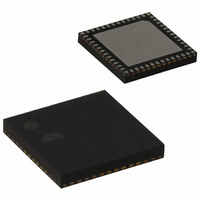EM357-RTR Ember, EM357-RTR Datasheet - Page 55

EM357-RTR
Manufacturer Part Number
EM357-RTR
Description
IC RF TXRX ZIGBEE 192KB 48QFN
Manufacturer
Ember
Specifications of EM357-RTR
Frequency
2.4GHz
Data Rate - Maximum
250kbps
Modulation Or Protocol
802.15.4 Zigbee
Applications
General Purpose
Power - Output
5dBm
Sensitivity
-100dBm
Voltage - Supply
2.1 V ~ 3.6 V
Current - Receiving
26mA
Current - Transmitting
31mA
Data Interface
PCB, Surface Mount
Memory Size
192kB Flash, 12kB RAM
Antenna Connector
PCB, Surface Mount
Operating Temperature
-40°C ~ 85°C
Package / Case
48-QFN
Lead Free Status / RoHS Status
Lead free / RoHS Compliant
Other names
636-1011-2
Available stocks
Company
Part Number
Manufacturer
Quantity
Price
Company:
Part Number:
EM357-RTR
Manufacturer:
SILICON
Quantity:
3 000
Part Number:
EM357-RTR
Manufacturer:
SILICON
Quantity:
20 000
- Current page: 55 of 245
- Download datasheet (12Mb)
7.2
Configuration
Each of the three GPIO ports has the following registers whose low-order eight bits correspond to the port’s
eight GPIO pins:
In addition to these registers, each port has a pair of configuration registers, GPIO_PxCFGH and GPIO_PxCFGL.
These registers specify the basic operating mode for the port’s pins. GPIO_PxCFGL configures the pins Px[3:0]
and GPIO_PxCFGH configures the pins Px[7:4]. For brevity, the notation GPIO_PxCFGH/L refers to the pair of
configuration registers.
Five GPIO pins (PA6, PA7, PB6, PB7 and PC0) can sink and source higher current than standard GPIO outputs.
Refer to Table 2-5, Digital I/O Specifications in Chapter 2, Electrical Characteristics, for more information.
Each pin has a 4-bit configuration value in the GPIO_PxCFGH/L register. The various GPIO modes and their
4-bit configuration values are shown in Table 7-1.
If a GPIO has two peripherals that can be the source of alternate output mode data, then other registers in
addition to GPIO_PxCFGH/L determine which peripheral controls the output.
Several GPIOs share an alternate output with Timer 2 and the Serial Controllers. Bits in Timer 2’s TIM2_OR
register control routing Timer 2 outputs to different GPIOs. Bits in Timer 2’s TIM2_CCER register enable Timer
2 outputs. When Timer 2 outputs are enabled they override Serial Controller outputs. Table 7-2 indicates the
GPIO mapping for Timer 2 outputs depending on the bits in the register TIM2_OR. Refer to Chapter 9, General
Purpose Timers for complete information on timer configuration.
GPIO Mode
Analog
Input (floating)
Input (pull-up or
pull-down)
Output (push-
pull)
Output (open-
drain)
Alternate Output
(push-pull)
Alternate Output
(open-drain)
GPIO_PxIN (input data register) returns the pin level (unless in analog mode).
GPIO_PxOUT (output data register) controls the output level in normal output mode.
GPIO_PxCLR (clear output data register) clears bits in GPIO_PxOUT.
GPIO_PxSET (set output data register) sets bits in GPIO_PxOUT.
GPIO_PxWAKE (wake monitor register) specifies the pins that can wake the EM35x.
GPIO_PxCFGH/L Description
0xD
0x0
0x4
0x8
0x1
0x5
0x9
Table 7-1. GPIO Configuration Modes
Analog input or output. When in analog mode, the digital input
(GPIO_PxIN) always reads 1.
Digital input without an internal pull up or pull down. Output is
disabled.
Digital input with an internal pull up or pull down. A set bit in
GPIO_PxOUT selects pull up and a cleared bit selects pull down.
Output is disabled.
Push-pull output. GPIO_PxOUT controls the output.
Open-drain output. GPIO_PxOUT controls the output. If a pull up is
required, it must be external.
Push-pull output. An onboard peripheral controls the output.
Open-drain output. An onboard peripheral controls the output. If a
pull up is required, it must be external.
Final
7-2
EM351 / EM357
120-035X-000G
Related parts for EM357-RTR
Image
Part Number
Description
Manufacturer
Datasheet
Request
R

Part Number:
Description:
MODULE EM357 PA/LNA W/ANT TG
Manufacturer:
Ember
Datasheet:

Part Number:
Description:
MODULE EM357 NO PA/LNA W/ANT TG
Manufacturer:
Ember
Datasheet:

Part Number:
Description:
MODULE EM357 NO PA/LNA W/RF CONN
Manufacturer:
Ember
Datasheet:

Part Number:
Description:
MODULE EM357 PA/LNA W/RF CONN
Manufacturer:
Ember
Datasheet:

Part Number:
Description:
IC RF TXRX ZIGBEE 192KB 48QFN
Manufacturer:
Ember
Datasheet:

Part Number:
Description:
KIT DEV EMBER ZIGBEE W/PCWH
Manufacturer:
Custom Computer Services Inc (CCS)

Part Number:
Description:
PROGRAMMER USB FLASH EM250/260
Manufacturer:
Ember
Datasheet:

Part Number:
Description:
IC ZIGBEE SYSTEM-ON-CHIP 40-QFN
Manufacturer:
Ember
Datasheet:

Part Number:
Description:
IC ZIGBEE SYSTEM-ON-CHIP 48-QFN
Manufacturer:
Ember
Datasheet:

Part Number:
Description:
IC RF TXRX ZIGBEE 128KB 48QFN
Manufacturer:
Ember
Datasheet:

Part Number:
Description:
INSIGHT ADAPTER FOR EM2XX
Manufacturer:
Ember
Datasheet:

Part Number:
Description:
PROGRAMMER USB FLASH EM250/260
Manufacturer:
Ember
Datasheet:

Part Number:
Description:
IC ZIGBEE SYSTEM-ON-CHIP 40-QFN
Manufacturer:
Ember
Datasheet:

Part Number:
Description:
IC ZIGBEE SYSTEM-ON-CHIP 48-QFN
Manufacturer:
Ember
Datasheet:

Part Number:
Description:
IC RF TXRX ZIGBEE 128KB 48QFN
Manufacturer:
Ember
Datasheet:











